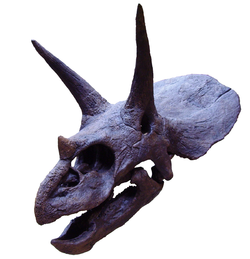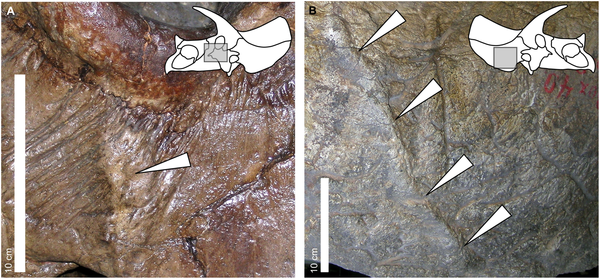If Triceratops fought each other with their horns, wounds from this combat would be preserved in the fossil bones so Farke joined forces with paleontologists Ewan Wolff of the School of Veterinary Medicine at the University of Wisconsin and Darren Tanke of the Royal Tyrrell Museum of Paleontology in order to search museum collections throughout North America for evidence of these injuries. The researchers focused on the skulls of Triceratops and a closely-related dinosaur, Centrosaurus.
"Paleontologists have debated the function of the bizarre skulls of horned dinosaurs for years now," said Farke. "Some speculated that the horns were for showing off to other dinosaurs, and others thought that the horns had to have been used in combat against other horned dinosaurs. Unfortunately, we can't just go and watch a Triceratops in the wild."

Triceratops skull with horns and frill. Credit: Oxford University Museum of Natural History.
"If Triceratops and Centrosaurus only used their horns and frills for showing off, we would expect no difference in the rate of injury for both animals," stated Farke. Instead, the team found that the squamosal bone, which forms part of the frill, was injured 10 times more frequently in Triceratops than in Centrosaurus. He added, "The most likely culprit for all of the wounds on Triceratops frills was the horns of other Triceratops."
Other paleontologists had also noted abnormalities in the skulls of horned dinosaurs, but later work found that at least some of these supposed injuries were caused by random, non-traumatic bone resorption similar to osteoporosis. Additionally, previous researchers only focused on a handful of specimens. The new study included over 400 observations, which were analyzed statistically to detect differences between Centrosaurus and Triceratops.
"In the past individual remains have been used to reconstruct the story of ancient injuries," said co-author Wolff. He continued, "I think this research shows the great potential of looking at injury patterns, even less obvious ones, to provide appropriate conclusions. The features we studied were very subtle and in many cases had been overlooked."
"Our findings provide some of the best evidence to date that Triceratops might have locked horns with each other, wrestling like modern antelope and deer," said Farke. The researchers speculate that many of the injuries they observed may have been caused by misplaced horn thrusts from rival animals. Similar injuries are occasionally seen in modern horned animals.

Examples of periosteal reactive bone in selected specimens of Triceratops. Arrows indicate lesions on (A) the left jugal of YPM 1822 (Yale Peabody Museum, New Haven, Connecticut, USA) and (B) the right squamosal of YPM 1828. The inset skull graphics indicate the approximate area of each photograph with a gray box.
Still, Farke is quick to caution that horned dinosaurs still might have used their horns and frills for uses beyond fighting. "I like to think of the headgear on Triceratops as a Swiss army knife," Farke said. "They probably used their skulls however they wanted, whether it was for combat, defense, or display."
The size and shape of the horns varied among different horned dinosaurs, and the researchers hypothesize that different horn shapes indicate different kinds of combat. Furthermore, some evidence suggests that certain species may have evolved different kinds of horns in order to reduce the risk of traumatic injury.
Citation: Farke AA, Wolff EDS, Tanke DH (2009) Evidence of Combat in Triceratops. PLoS ONE 4(1): e4252. doi:10.1371/journal.pone.0004252





Comments